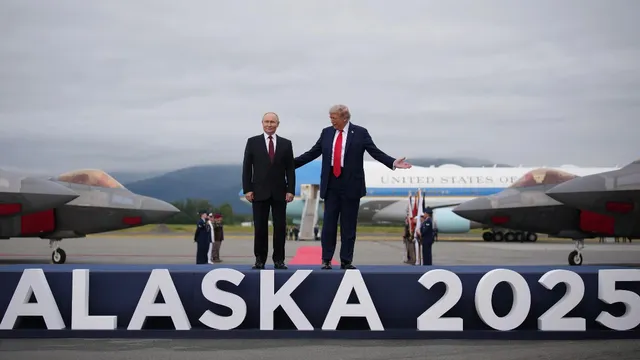- By Supratik Das
- Sat, 16 Aug 2025 07:25 AM (IST)
- Source:JND
Trump-Putin Alaska summit: US President Donald Trump welcomed Russian President Vladimir Putin on Friday with a warm reception as the two leaders initiated high-stakes negotiations in Alaska with a view to ending the ongoing war in Ukraine. The symbolic gestures, including the red-carpet welcome, a shared ride in the presidential limousine, and prolonged handshakes, failed to yield a breakthrough on a ceasefire, resulting in questions about what progress, if any, had been achieved.
Trump himself greeted Putin at Joint Base Elmendorf-Richardson in Anchorage, Alaska, where the Russian president landed under tight security. The two leaders shook hands for a prolonged period on a rolled-out red carpet as Cold War-era US warplanes, such as B-2 bombers and F-22 fighters, roared overhead in a tightly choreographed performance. While journalists yelled questions regarding Ukrainian civilian casualties, Putin smiled and waved as if he couldn't hear them. Later, both leaders stepped into the US presidential limousine, known as "The Beast," and shared a brief ride before proceeding to the meeting destination. The cordial reception—typically reserved for close US allies stood in stark contrast to the grim reality of the war in Ukraine, now the deadliest conflict in Europe since 1945.
High Stakes For Trump And Putin
Initially announced as a one-on-one meeting, the meeting opened up to a three-on-three format, with Trump accompanied by US Secretary of State Marco Rubio and special envoy Steve Witkoff. Putin also brought Foreign Minister Sergey Lavrov and foreign policy aide Yuri Ushakov. White House press secretary Karoline Leavitt stated the move was a "more guarded" tack than Trump's much-criticised 2018 Helsinki summit, during which he met with Putin alone and was widely chastised for allying himself with the Russian leader against US intelligence agencies. This time, the leaders sat with aides in front of a backdrop featuring the words "Alaska" and "Pursuing Peace."
#WATCH | Alaska, USA | US President Donald Trump and Russian President Vladimir Putin exchange greetings in Anchorage, ahead of their talks.
— ANI (@ANI) August 15, 2025
Source: Reuters pic.twitter.com/mdGoQe6qqx
For Trump, the Alaska summit was a test of his own claimed ability as a dealmaker and peacemaker. He has long claimed he would end the Russia-Ukraine conflict "within 24 hours" if he were elected, but so far has failed to make good on the pledge. He had previously indicated to reporters that there was a "25 percent chance" the summit would collapse completely, but also suggested a second three-party meeting involving Zelenskyy and Putin if things went well. For Putin, the trip to American soil itself was a symbolic triumph. Following years of global pariah status and an ICC warrant for his arrest on allegations of war crimes, the Russian president leveraged the summit to demonstrate Moscow's resurrection onto the world diplomatic scene. Experts claimed the red-carpet welcome and joint photos with Trump would enable Putin to assert legitimacy at home and abroad, whether the negotiations were successful or not.
Sticking Points And Risks
The talks were set to address Russian demands that Ukraine give up land and drop its hopes of joining NATO. Trump has indicated that he would "let Ukraine decide" whether to offer territorial concessions, but hinted Zelenskyy may ultimately have to settle for compromises. Another sensitive topic was US and allied security guarantees for Ukraine. Trump indicated Washington could consider offering assurances “alongside European partners, but not in the form of NATO,” a position more aligned with Moscow’s demands. NATO’s Supreme Allied Commander Europe, Gen. Alexus Grynkewich, was also present in Alaska to advise Trump and Defense Secretary Pete Hegseth, underscoring European anxieties that Washington might yield too much ground.
#WATCH | Alaska, USA | US President Donald Trump and Russian President Vladimir Putin hold talks in Anchorage, focused on the Russia-Ukraine war.
— ANI (@ANI) August 15, 2025
Russia's Foreign Minister Sergey Lavrov and US Secretary of State Marco Rubio, along with other officials, are also present.… pic.twitter.com/4zQKP5Y5wL
The venue of Alaska lent an air of symbolism to the top. US bought Alaska from Russia in 1867, a historical deal that still holds meaning in Moscow. Joint Base Elmendorf-Richardson, which used to be a Cold War center for tracking Soviet activity, remains in a frontline position intercepting Russian planes close to US borders. The proximity—only three miles stand between Alaska and Russian land across the Bering Strait—highlighted the sensitivity and urgency of the negotiations.
The Road Ahead
Meanwhile, the war rages on, with Ukrainian cities enduring heavy bombardment and casualties mounting on both sides along a front line stretching more than 1,000 kilometers.
Although the Alaska summit concluded without a signed ceasefire or peace agreement, both leaders left open the possibility of more talks. Trump signaled "a very good chance" of an agreement in future discussions, and Putin hinted that "the understanding reached today" could lead to productive diplomacy. As the Russian president departed, he joked to Trump: "Next time in Moscow." The warm optics in Alaska immediately drew concern from Ukrainian President Volodymyr Zelenskyy and European leaders, who fear Trump may prioritize US strategic interests over Ukraine’s demands. Zelenskyy, excluded from the summit, delivered a video address urging Washington to take a firm stand. “Everyone wants an honest end to the war. Ukraine is ready to work as productively as possible to end the war,” he said. “But the war continues precisely because there are no signals from Moscow that it is preparing to end this.” European governments, long committed to the principle of “nothing about Ukraine without Ukraine,” worry that bilateral US-Russia talks could sideline Kyiv. Czech and Baltic leaders in particular have expressed unease that Putin could use the summit to gain diplomatic legitimacy while continuing his military offensive.
Whether the Alaska summit is a watershed moment in the globe's deadliest war in decades—or just another platform for theatrics rests on whether both leaders are ready to move beyond red carpets and handshakes to genuine compromise.

